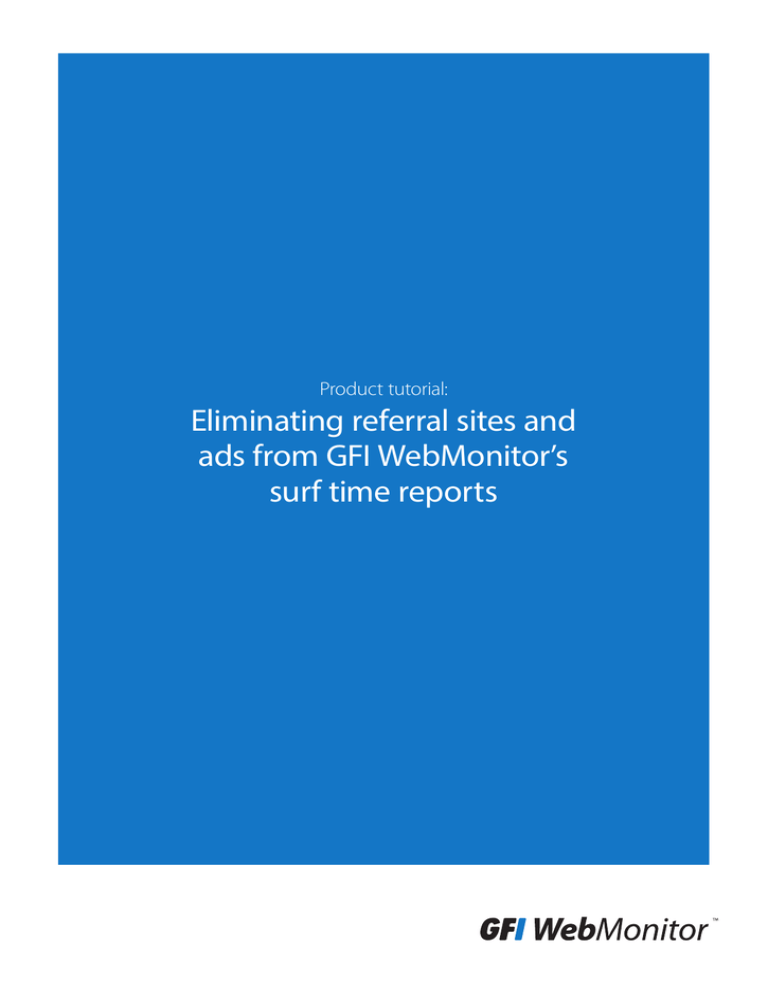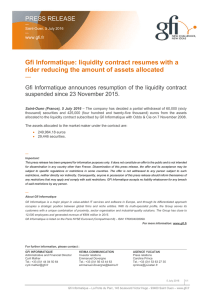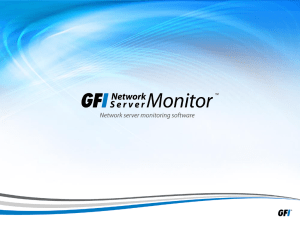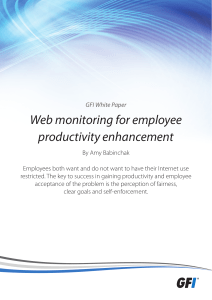
Product tutorial:
Eliminating referral sites and
ads from GFI WebMonitor’s
surf time reports
Contents
Intentional vs. unintentional web activity
3
How does GFI WebMonitor solve this problem? 5
Conclusion
12
GFI product tutorial - Eliminating referral sites and ads from GFI WebMonitors surf time reports | 2
Intentional vs. unintentional web activity
One of the biggest challenges IT admins face as they try to monitor and measure web activity is
distinguishing between direct (intentional) web browsing activity requests and indirect
(unintentional) requests.
Take the following as an example. There is a difference between a user browsing to www.facebook.com
and a user who goes to a work-related business site like www.techcrunch.com which embeds code that
invokes social media content such as ‘liking’, ‘sharing’ or ‘commenting’.
Figure 1: An example of a direct (intentional) web request to a social media platform.
GFI product tutorial - Eliminating referral sites and ads from GFI WebMonitors surf time reports | 3
Figure 2: An example of an indirect (un-intentional) web request to social media platform.
From the end user’s point of view, one might argue that he or she did not go to www.facebook.com or
engage in direct Facebook activity. However, technically, when one looks under the hood, the nature of
dynamic sites and embeddable content does indeed generate requests to social sites. This embedded
content generally takes the form of components which appear on pages as ‘Share’ buttons, ‘Like’ buttons,
‘Comment’ sections, as well as adverts etc.
Moreover, sites which embed social media content such as Facebook login cookies generally load
additional content to enhance the web experience for that user. Such an example would be the
Facebook ‘Like’ button, or a comments section also displaying the picture of the currently logged in
user etc. The reality is that while the user is interested in the main content, dynamic embedded content
requests do occur.
GFI product tutorial - Eliminating referral sites and ads from GFI WebMonitors surf time reports | 4
Administrators need a solution whereby they can differentiate between ‘noise’ requests such as
advertisement and social media platform referrals and intentional site visits initiated by users.
How does GFI WebMonitor solve this problem?
Out of the box, GFI WebMonitor ships with web filtering policies which enable IT admins to discover,
manage and secure all activity. GFI WebMonitor gives administrators options to exclude these
advertisement and social media referrals from loading in a website and in terms of reporting:
Firstly, you can configure GFI WebMonitor to totally block access to an entire category of web ads content
found under ‘Web Advertisements’. You can manage your policies by:
1. Clicking on ‘Manage’ and then ‘Policies’ in the main configuration
2. Here you can either edit an existing policy or create a new one
3. In the ‘Websites’ section, either type in ‘Web Advertisements’ or select its icon from the website
category list.
GFI product tutorial - Eliminating referral sites and ads from GFI WebMonitors surf time reports | 5
By blocking this category alone, users will be not have web advertisement content, such as the
below presented to them. We do not recommend blocking CDNs as this might cause many websites
to load incorrectly.
Figure 3: An example of embedded web advertisement content which can be blocked.
GFI product tutorial - Eliminating referral sites and ads from GFI WebMonitors surf time reports | 6
Figure 4: AOL advertisement has been blocked for the user
This not only prevents the advertisement content from loading on the website, but correctly categorizes
the content as ‘Web Advertisements’ or ‘CDNs’ thus giving more accurate surf time reports.
GFI product tutorial - Eliminating referral sites and ads from GFI WebMonitors surf time reports | 7
Figure 5: GFI WebMonitor Surf report listing the AOL advertisement as a CDN.
GFI product tutorial - Eliminating referral sites and ads from GFI WebMonitors surf time reports | 8
You can then edit your reports to exclude CDNs and Web Advertisements as shown below:
1. Click on ‘Reports’ in the main configuration
2. Select your desired report and click on the pen ‘edit’ icon
3. Click on the ‘Data’ tab, exclude the ‘CDNs’ and ‘Web Advertisement’ web categories and hit save.
Figure 6: Excluding CDNs and Web Advertisements from reports.
GFI product tutorial - Eliminating referral sites and ads from GFI WebMonitors surf time reports | 9
Secondly, you can enable ‘Full URL Logging’ in GFI WebMonitor to determine what URLs are being
accessed and exclude them from your reports accordingly.
To enable full URL logging, follow these steps:
1. Open the GFI WebMonitor configuration and go to Manager > Policies
2. Here you can either edit an existing policy or create a new one
3. Scroll to the bottom of the policy editing screen and select the ‘Enable full URL logging’ box:
With full URL logging, IT administrators get granular visibility into each URL that is being accessed. If
simple URLs like facebook.com, or profiles*.facebook.com are reported, this means that a user typed in
Facebook and logged on (an intentional action). Other URLs having cdn* usually represent Facebook
resources such as ‘Like’, ‘Share’ and ‘Comment’ content embedded in any website, even work-related. Once
these URLs are identified, administrators can tweak their reports to only include the basic (intentional)
URLs above. For example, administrators can add “ads.google*” or simply “ads*” to the reporting exclusion
lists. The reports will then only list intentional activity such as loading the main page of Facebook and
logging on.
GFI product tutorial - Eliminating referral sites and ads from GFI WebMonitors surf time reports | 10
To edit reports to add these exclusions, follow these steps:
1. Open the GFI WebMonitor configuration and go to Manager > Policies
2. Select your desired report and click on the pen ‘edit’ icon
3. Click on the ‘Data’ tab and edit accordingly:
Figure 7: Excluding advertisement content from reports
GFI product tutorial - Eliminating referral sites and ads from GFI WebMonitors surf time reports | 11
4. If needed, entire content from applications can be excluded as well:
Figure 8: Excluding entire web applications from reports
Modern applications usually load content from HTML, asp(x), flash movie and other pages so
administrators can further filter the report to only include those resources (while still allowing that
content to be browsed). Same applies to Javascript and flash objects which are not movies.
Conclusion
Administrators need a solution whereby they can differentiate between ‘noise’ web requests such as
advertisement and social media platform referrals and intentional site visits initiated by users. In order to
achieve this, administrators must first be able to get a sense of what content is being loaded, from where
and how. GFI WebMonitor enables administrators to easily discover, monitor and differentiate between
web requests by leveraging its powerful and granular web filtering engine. Once administrators gain indepth insight into what undesired content is being presented to users, and reported, they can leverage
GFI WebMonitor to manage and secure all activity by blocking undesired web content as well as refining
their business reports accordingly.
GFI product tutorial - Eliminating referral sites and ads from GFI WebMonitors surf time reports | 12
© 2014. GFI Software. All rights reserved. All product and company names herein may be trademarks of
their respective owners.
The information and content in this document is provided for informational purposes only and is
provided “as is” with no warranty of any kind, either express or implied, including but not limited to the
implied warranties of merchantability, fitness for a particular purpose, and non-infringement. GFI Software
is not liable for any damages, including any consequential damages, of any kind that may result from the
use of this document. The information is obtained from publicly available sources. Though reasonable
effort has been made to ensure the accuracy of the data provided, GFI makes no claim, promise or
guarantee about the completeness, accuracy, recency or adequacy of information and is not responsible
for misprints, out-of-date information, or errors. GFI makes no warranty, express or implied, and assumes
no legal liability or responsibility for the accuracy or completeness of any information contained in this
document.
If you believe there are any factual errors in this document, please contact us and we will review your
concerns as soon as practical.
www.gfi.com
For a full list of GFI offices/contact details worldwide,
please visit: www.gfi.com/contact-us
CDT381 dec14
Disclaimer





